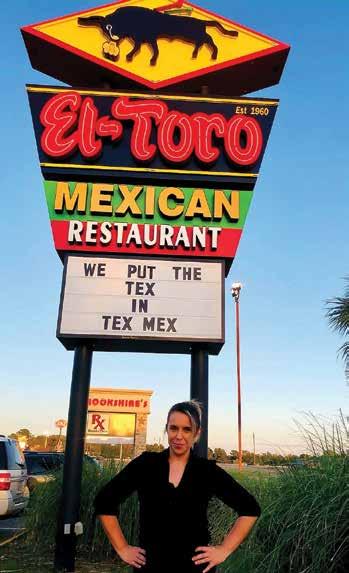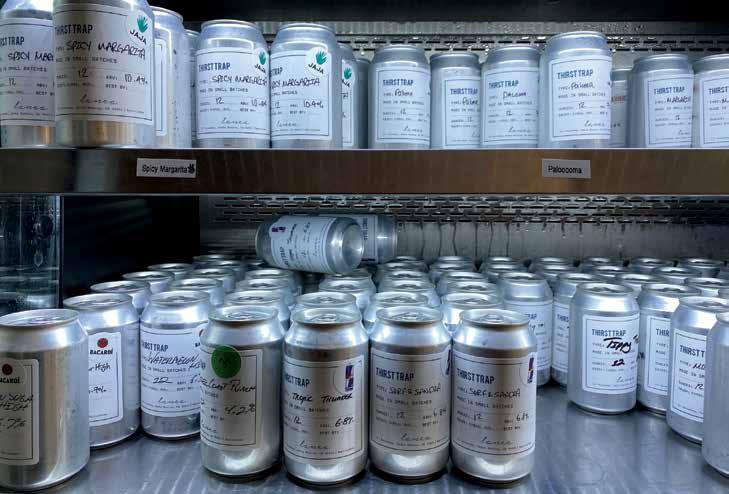
17 minute read
AT THE BAR—Canned Cocktails
PHOTO COURTESY OF LANEA
Canned Cocktails? YES, YOU “CAN”
| BY ELYSE GLICKMAN | Canned hard seltzers, wine cocktails, ciders and various mixed libations—once banned behind any reputable bar—are converting skeptical consumers with creative flavors, bold packaging and clever branding.
But can cocktails in cans really play a profitable part in Mexican restaurants?
The answer: “Yes they can!”
2020: A TURNING POINT In the pre-pandemic world, handing customers a canned version of a Margarita, paloma, mojito or caipirinha instead of an elaborately prepared craft drink was almost unthinkable. Even in the fast-casual realm, a canned cocktail—no matter how beautifully packaged—may not have meshed with the brand image the restaurant was striving to create.
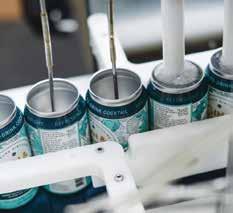
You & Yours’ canning system
Enter COVID…exit the hesitance to serve canned cocktails.
When carry-out, delivery and outdoor dining became the norm, and regional liquor laws loosened, restaurateurs and bar managers began to see canned drinks as one solution to pandemic-induced problems.
That was the case for Bitter & Twisted Cocktail Parlour in Phoenix and Lanea in Santa Monica, California—both destinations that have earned a loyal following through their innovative cocktail programs.
Partnering for a “Can-Do” Solution
Not every restaurant has the space, staf or even the inclination to set up an inhouse cocktail canning operation. That doesn’t mean custom canned cocktails are out of the question. Partnering with a canning company to create signature beverages is one option—and it’s one The Godfrey Hotel Chicago decided to try.
Just before the pandemics’ onset, hotel management had been looking to expand the kind of drinks ofered in guest room mini bars as well as those available at its I|O Rooftop Lounge.
“We wanted our canned drinks to be a clever way guests, and Chicagoans doing takeout and delivery, could take the Godfrey Hotel experience home with them,” says Grant Gedemer, food and beverage director, who notes that Mexican food items are among the most popular at the venue.
That became even more important after the pandemic hit, as I|O Rooftop Lounge began relying on carry out and delivery orders to keep revenue fowing.
Since on-site canning wasn’t feasible, Gedemer turned to outside companies for help.
“It was very important for us to work with companies that were operating in Chicago and had a reputation for making things from scratch,” he recalls.
Gedemer paid close attention to projects distilleries had worked on for other restaurants, watching how well the customized products they’d created represented the food, décor and cocktail quality those restaurants were known for in pre-pandemic times. He also took into account shelf-stability, packaging artwork, and the cost to create the kind of customized, portable cocktails that would refect The Godfrey’s upscale image—and questioned if it was possible to remain proftable.
He chose Chicago Distilling Company, a family-operated distillery in the city’s
BITTER & TWISTED When COVID-19 hit, Ross Simon, founder of Bitter & Twisted, knew he had to act quickly to determine how the bar could continue generating revenue to pay rent and expenses without being fully open to the public. Creating the “Portable Potables” line of canned cocktails in-house was the answer.
While other bars and restaurants were offering cocktails to go, Simon didn’t think the containers and recipe modifica-
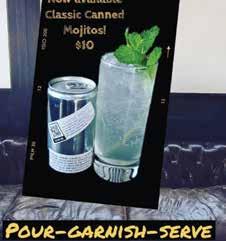
Bitter & Twisted’s Mojito tions he was seeing would be in keeping with Bitter & Twisted’s reputation as one of Phoenix’s most innovative bars.
“We had our canned concept in place, but not a proven way to bring it to life,” says Simon, who admitted that figuring out on-premise canning was challenging since the process is more complex than canning beer. Many canning companies he approached had never created shelfstable mixed drinks and didn’t have experience implementing the different steps required for canning carbonated vs. non-carbonated cocktails.
“It’s not simply about making a cocktail and pouring into a can. You can do that, but the shelf life won’t be there because you’ve got oxygen mixed in with it,” Simon explains. “And obviously, when you’re dealing with fresh juices, if you’re doing something outside of a Manhattan or an Old Fashioned, you run into issues with oxygenation, which degrades the quality of your cocktail.”
Simon ultimately settled on canning equipment from Oktober Can Seamers, a
Bitter & Twisted’s single-serve cocktails
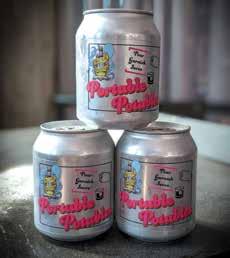
company based in Grand Rapids, Michigan. Overall, he’s happy with the results (which include drinks like the Classic Canned Mojito and the Watermelon Hibiscus Margarita, which comes with a vacuum-packed bag of of Tajin salt for garnish).
“We’ve replicated [our cocktails] to a degree that we’re very happy with the end product. It’s amazing that we pour a can over ice and it’s the same quality as what we had in the bar,” Simon reports. (continued on page 38)
Logan Square neighborhood, “because it had a well-established ‘craft’ mindset.”
Jay DiPrizio, co-owner of Chicago Distilling Co. with his wife Noelle, says his customized work for bars and restaurants has always come from an interest in packaging a signature or namesake cocktail that builds on the in-house guest experience—a goal more important than ever in today’s challenging hospitality climate.
There’s also the option to ofer canned cocktails that aren’t specifcally custommade for your restaurant. Chicago Distilling Company ofers a variety of those, as does San Diego-based You & Yours Distilling Co.—described as “California’s frst urban distillery.”
Laura Johnson, distiller of You & Yours, says the company invested “lots of thought and planning over two years” to develop its line of canned cocktails—all distilled, mixed, chilled and carbonated in-house. She says several of them—including the Vodka Mule and Key Lime Vodka Soda— “naturally lend themselves really well to Mexican favors and popular Mexican/Latin dishes.
“Restaurants and bars need to determine the volume minimums they’ll need to take on in order to collaborate and how much, if any, control over the formulation process they can have,” Johnson adds.
No matter your reason for embracing canned cocktails, one thing is clear: The trend appears to be primed to stay around for quite a while—even after the pandemic subsides.
As DiPrizio says, “Customers come to restaurants/bars for an experience. I don’t see why they wouldn’t want to bring a piece of that experience home with them, or to their next socially distanced cocktail party! I also see more and more brewers trying to replicate some of the aspects of cocktails into their beers via fruit infusions and hop selections. Why let beer win the fridge battle? Let’s make room for some cocktails!”


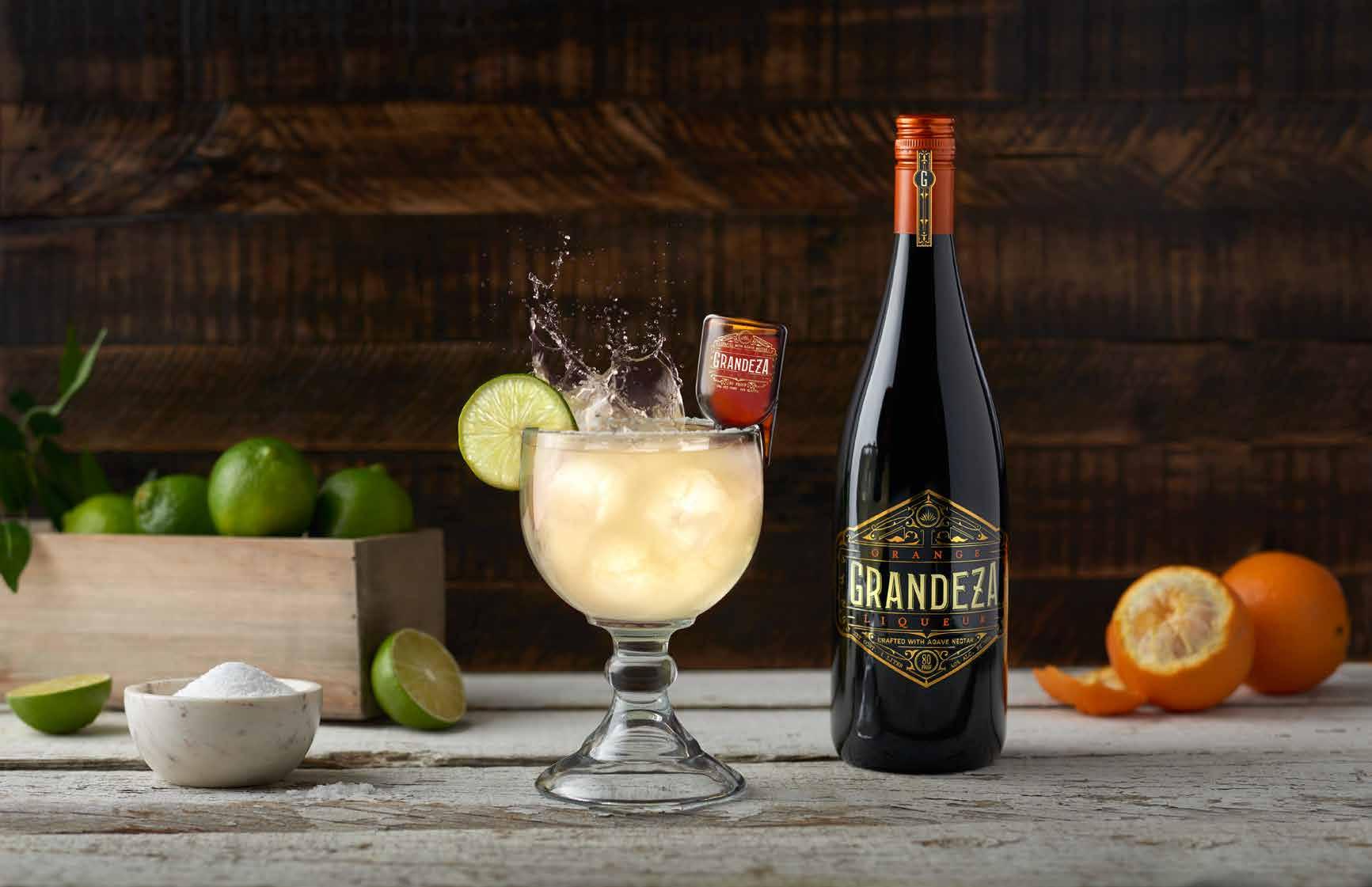

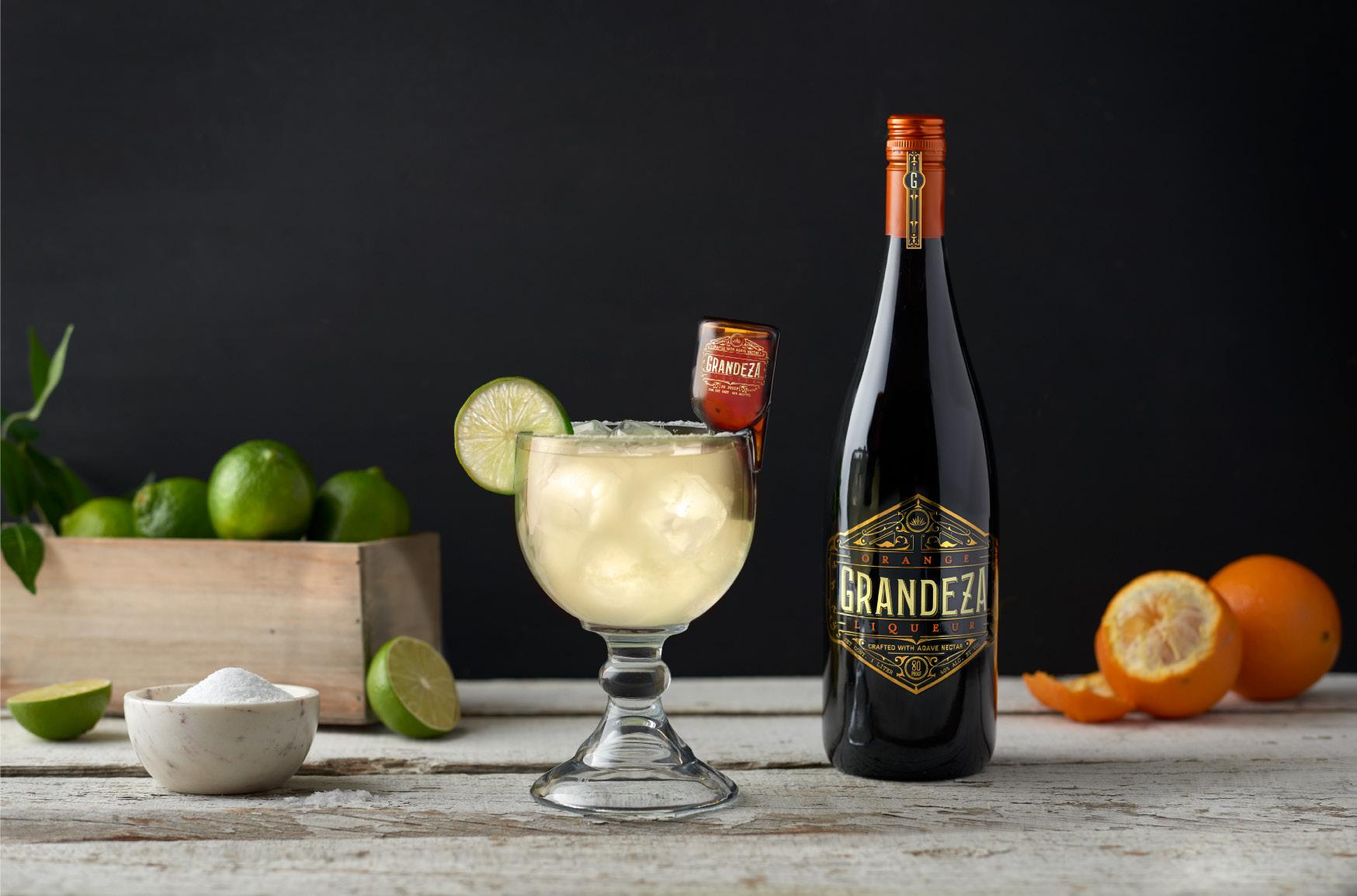
CUSTOM CANNING AND IN-HOUSE CANNING SOLUTIONS aren’t for every venue. And for anyone considering the custom canning route, there are many things to understand and take into account before making the leap. Here are a few DiPrizio says are important to consider:
The equipment you’ll need. The “short list” to set something up on-premise includes CO2 bulk tanks, regulators, carbonation tanks (although small-scale bars can experiment in kegs), carbonation stones, chillers, a canning line, industrial juicers, aluminum cans and lids.
“Bar owners would want to fnd a manual canning system, so visit a local brewery and see what they use if they package in cans,” he suggests. “Beer canning lines are 80 percent set up to can cocktails, but there are some modifcations you have to make to the equipment to reach proper carbonation rates.” The approved thresholds for ABV, chlorides and PH in canned goods. Understanding these is important because “are all necessary so the liner of the cans doesn’t dissolve into the cocktail and cause leaching of plastic or can failure,” DiPrizio explains.
Your ability to implement quality controls. “We’ve learned that in the U.S., it’s smart to be insured and have a recall plan,” DiPrizio says. “Batch tracking is important, and I can’t emphasize enough how important quality control and corrosion testing are when dealing with aluminum.”
The end result, however, was not easily achieved.
“There was a lot of work leading to that. We re-devised ways to ensure lemon and lime components would not go off, tinkered with the drinks’ strength and figured out how to use nitrogen to stabilize the product until someone opens the can,” Simon recalls. “In terms of the cost of Portable Potables for the guest, it will cost a little bit more [than a pre-made canned cocktail from a distributor], but it’s in line with what we’re doing in the bar. When customers purchase our cans, they understand they are supporting lo-
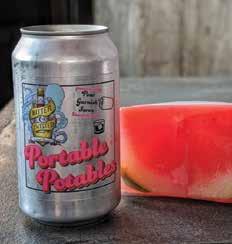
Bitter & Twisted’s Watermelon-Hibiscus Margarita comes with vacuum-packed Tajin salt cal producers and places that will hopefully reopen.”
Simon anticipates the canned cocktails will help the bar maintain revenue streams, whether customers buy them to enjoy at the bar, at home or on the go. He also points out canning will help prevent waste as it allows his bartenders to use up fresh ingredients needed for craft cocktails before they spoil.
LANEA Bar director John Neumueller says launching Lanea’s on-premise canning operation has been a labor-intensive process that’s reaped positive results.
“We went through everything we could think of as far as vessels, recipes, sizes…you name it, we probably R&D’d it in some way, shape or form,” confides Neumueller. “Thankfully, as home-brewing beer is a pretty popular hobby, it wasn’t too difficult to come by most of the supplies we needed online to retrofit our
Canning a cocktail at Lanea
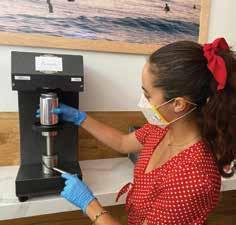
bar to be a full-blown canning operation. When translating the plans to reality, we wanted to make sure nothing felt like a compromise and that the drink guests would be enjoying feels polished and official—like something they could only achieve by going out.”
The cocktails “travel super well, and the quality is top notch,” he reports, noting that “most of our guests are stoked on the cans.”
One benefit beyond the extra income stream is that staff members “have fallen in love with the learning process” and have picked up new skills that are helping them adapt to the current situation while still achieving the quality customers expect. “This is a whole new way to approach drink-making and hospitality,” Neumueller says. “It’s a chance to embrace the exciting chance to get to learn again and try your hand at something new. It’s less a matter of space and machinery and more about understanding the trajectory of the industry and finding your place as things move forward.
“We’re not here to pontificate or give a step by step guide on how to can beverages like we’re any sort of pioneer,” he continues. “The pop top can was invented in the 60s. So, there’s decades of information to mine out there. Take the time, do some homework and I guarantee you’ll be able to find the resources and materials that are right for you.”
Elyse Glickman, el Restaurante’s At the Bar columnist, is a Los Angeles-based writer who specializes in covering topics related to the restaurant and bar industry.
| POR ELYSE GLICKMAN | Los refrescos alcohólicos, cocteles de vino, sidras y varias bebidas mezcladas en lata (alguna vez prohibidas detrás de cualquier bar de renombre) están transformando a clientes escépticos con sabores creativos, envases audaces y marcas ingeniosas.
Pero ¿los cocteles en lata realmente pueden tener una función rentable en los restaurantes mexicanos?
La respuesta es: “Sí, ¡si les late!”
2020: UN PUNTO DECISIVO En el mundo prepandemia, dar a los clientes una versión en lata de una margarita, paloma, mojito o caipiriña en lugar de una bebida elaborada y preparada a mano era casi impensable. Incluso en áreas informales, un coctel en lata (sin importar que estuviera bien envasado) probablemente no habría encajado con la imagen de marca que el restaurante procuraba crear.
Entra la COVID… sale la reticencia de ofrecer cocteles en lata.
Cuando los servicios para llevar, de entrega a domicilio y comidas al aire libre se convirtieron en la regla, y se relajaron las leyes regionales sobre alcoholes, los dueños de restaurantes y gerentes de bares comenzaron a ver en las bebidas en lata una solución a los problemas causados por la pandemia.
Ese fue el caso de Bitter & Twisted Cocktail Parlour en Phoenix, y de Lanea en Santa Mónica, California: dos destinos que se han ganado seguidores fieles a través de sus innovadores programas de cocteles.
BITTER & TWISTED
Cuando llegó la COVID-19, Ross Simon, fundador de Bitter & Twisted, supo que tenía que actuar rápidamente para decidir la forma en la que el bar seguiría
PHOTO DE LANEA

¿Cocteles en lata? SÍ, SI LE “LATEN”
generando ingresos para pagar la renta y los gastos sin estar completamente abierto al público. Crear dentro del local la línea “Portable Potables” de cocteles en lata fue la respuesta.
Mientras que otros bares y restaurantes ofrecían cocteles para llevar, Simon no pensó en que los recipientes y las modificaciones de fórmulas que veía eran acordes a la reputación de Bitter & Twisted de ser uno de los bares más in-

You & Yours’ canning system novadores de Phoenix.
“Teníamos previsto nuestro concepto en lata, pero no una forma comprobada de hacerlo realidad”, dice Simon, quien admitió que resolver el tema del envasado en el local fue complicado dado que el proceso es más complejo que envasar cerveza. Muchas empresas de envasado a las que él se acercó nunca habían creado bebidas combinadas no perecederas, y no tenían experiencia aplicando los diferentes pasos necesarios para preparar los cocteles carbonatados frente a los cocteles no carbonatados.
“No se trata simplemente de preparar un coctel y verterlo en una lata. Puede hacerlo, pero no habrá caducidad porque ahí tiene oxígeno combinado”, explica Simon. “Y obviamente, cuando está manejando jugo fresco y hace algo que
LAS SOLUCIONES DE ENVASADOS EN LATA PERSONALIZADOS y dentro del local no son para todos los lugares. Y para cualquier persona que considere tomar la ruta del envasado personalizado, hay muchas cosas que comprender y contemplar antes de dar el gran salto. Aquí hay unos cuantos consejos que DiPrizio dice que es importante considerar:
El equipo que necesitará. La “lista corta” para instalar algo en el local incluye tanques de CO2, reguladores, tanques de carbonatación (aunque algunos bares a menor escala pueden hacer pruebas con barriles), piedras de carbonatación, enfriadores, línea de envasado, exprimidores industriales, latas de aluminio y tapas.
“Los propietarios de bares querrán encontrar un sistema manual de envasado, así que visite una fábrica de cerveza local y, si envasa en latas, vea lo que usa”, sugiere. “Las líneas de envasado de cerveza están confguradas al 80 por ciento para envasar cocteles en lata, pero hay algunas modifcaciones que tiene que hacer al equipo para llegar a los índices adecuados de carbonatación”.
Los límites aprobados de ABV, cloruros y pH en productos enlatados. Comprenderlos es importante porque “todos son necesarios para que el recubrimiento de las latas no se disuelva en el coctel y ocasione lixiviación de plástico o fallo de la lata”, explica DiPrizio.
Su capacidad para implementar controles de calidad. “Hemos aprendido que en los EE. UU., es inteligente estar protegido y tener un plan de retiro del producto”, dice DiPrizio. “El seguimiento de lotes es importante, y no me canso de hacer énfasis en la importancia del control de calidad y de las pruebas de corrosión cuando se maneja aluminio”.
no es un Manhattan o un Old Fashioned, encuentra problemas con la oxigenación, lo cual degrada la calidad de su coctel”.
Finalmente, Simon se decidió por el equipo de enlatado de Oktober Can Seamers, una empresa con sede en Grand Rapids, Michigan. En general, está contento con los resultados (entre los que se incluyen bebidas como el mojito clásico en lata y la margarita de sandía e hibisco, la cual trae una bolsa envasada al vacío de polvo Tajín para adornar).
“Hemos replicado [nuestros cocteles] a un nivel en el que estamos contentos con el producto final. Es increíble que vaciamos una lata sobre hielo y tiene la misma calidad que teníamos en el bar”, informa Simon.
Sin embargo, el resultado final no se logró fácilmente.
“Hubo muchísimo trabajo para llegar ahí. Volvimos a idear formas de garantizar que los componentes de lima y limón no se echen a perder, alterados con la intensidad de las bebidas, y averiguamos cómo usar el nitrógeno para estabilizar el producto hasta que alguien abra la lata”, recuerda Simon. “En términos del costo de Portable Potables para el visitante,
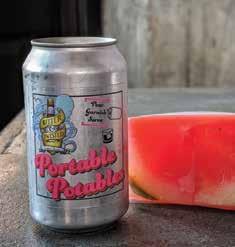
Photo de Bitter & Twisted Photo de Lanea
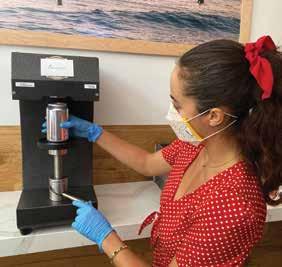
costará un poco más [que un coctel en lata preelaborado de un distribuidor], pero sigue la misma línea de lo que estamos haciendo en el bar. Cuando los clientes compran nuestras latas, comprenden que están apoyando a productores locales y lugares que esperamos que reabran”.
Simon prevé que los cocteles en lata ayudarán a que el bar mantenga las fuentes de ingresos, ya sea que los clientes los compren para disfrutarlos en el bar, en casa o en el camino. También señala que el envasado ayudará a evitar desperdicios, ya que permite que los bármanes utilicen los ingredientes frescos necesarios para preparar cocteles antes de que se echen a perder.
LANEA John Neumueller, jefe del bar, dice que lanzar la operación de envasado en el local de Lanea ha sido un proceso de trabajo intenso que ha cosechado resultados positivos.
“Pasamos por todo lo que pudimos imaginar en cuanto a vasijas, fórmulas, tamaños… por mencionar algunos, probablemente hicimos investigación y desarrollo (I+D) de algún modo o forma”, confía Neumueller. “Por fortuna, como la elaboración de cerveza casera es un pasatiempo bastante popular, no fue muy difícil encontrar en línea la mayoría de los materiales que necesitábamos para renovar nuestro bar y que tenga una operación de envasado completo. Al hacer realidad los planes, quisimos asegurarnos
de que nada se sintiera como un compromiso y que los visitantes disfrutarían de una sensación refinada y oficial, como algo que solo pueden obtener saliendo”.
El coctel “se transporta super bien y la calidad es de primer nivel”, asegura, destacando que “la mayoría de nuestros visitantes están emocionados con las latas”.
Una ventaja que hay detrás de la fuente de ingresos adicional es que los miembros del personal “se han enamorado del proceso de aprendizaje” y han adquirido habilidades nuevas que los están ayudando a adaptarse a la situación actual, y al mismo tiempo consiguen la calidad que los clientes esperan.
Photo de Bitter & Twisted

“Esta es una manera completamente nueva de elaborar bebidas y de hotelería”, dice Neumueller. “Es una oportunidad de aceptar la emocionante oportunidad de aprender otra vez y probar sus habilidades en algo nuevo. No se trata tanto de espacio y maquinaria, se trata más de comprender el curso de la industria y encontrar su lugar mientras las cosas avanzan.
“No estamos aquí para pontificar u ofrecer una guía paso por paso sobre cómo envasar bebidas en lata como si fuéramos algún tipo de pionero”, continúa. “La lata abrefácil se inventó en los años 60. Entonces, hay décadas de información por ahí para extraer. Tómese el tiempo, busque información y le garantizo que podrá encontrar los recursos y materiales que son adecuados para usted”.
An Association for You!

The Latino Food Industry Association is a new organization designed specifically for you! The members are owners of Hispanic restaurants, grocery stores, suppliers, and other organizations involved in the food industry. The LFIA ofers a wide range of benefits to members, ranging from marketing assistance to technology services to advocacy.


el Restaurante is proud to be a member of LFIA. Learn more and join at latinofoodindustry.org
La Asociación Latina de la industria de alimentos La Asociación Latina de la industria de alimentos (LFIA-Latino Food Industry Association) es una nueva organización diseñada específicamente para usted! Los miembros son propietarios de restaurantes, mercados, proveedores de alimentos, y toda clase de organizacion involucrada en la industria alimentaria. La LFIA Ofrece muchos beneficios para sus miembros. Beneficios que inluyen la asistencia de márketing, servicios tecnológicos y abogacía gubernamental.







